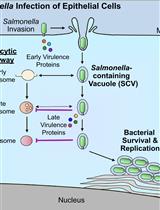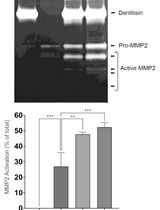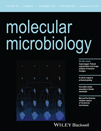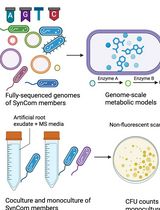- EN - English
- CN - 中文
Bacterial Survival in Dictyostelium
盘基网柄菌中细菌存活能力的检测
(*contributed equally to this work) 发布: 2017年07月05日第7卷第13期 DOI: 10.21769/BioProtoc.2376 浏览次数: 8905
评审: Valentine V TrotterAnonymous reviewer(s)

相关实验方案

细菌病原体介导的宿主向溶酶体运输的抑制:基于荧光显微镜的DQ-Red BSA分析
Mădălina Mocăniță [...] Vanessa M. D'Costa
2024年03月05日 2849 阅读

通过制备连续聚丙烯酰胺凝胶电泳和凝胶酶谱分析法纯化来自梭状龋齿螺旋体的天然Dentilisin复合物及其功能分析
Pachiyappan Kamarajan [...] Yvonne L. Kapila
2024年04月05日 2006 阅读
Abstract
We performed an assay to test the ability of different E. coli strains to survive inside amoebal cells after ingestion. In the assay we incubated bacteria together with cells of Dictyostelium discoideum for six hours. After co-incubation most of the uningested bacteria were removed by centrifugation and the remaining uningested bacteria were killed by gentamicin. Gentamicin is used because it does not penetrate into eukaryotic cells allowing the ingested bacteria to survive the antibiotic treatment, whereas bacteria outside the amoebal cells are killed.
Keywords: Bacteria (细菌)Background
Bacteria have evolved several different strategies to avoid or resist protozoan predation (Rønn et al., 2012). Mechanisms that reduce chance of ingestion such as increased cell size, aggregation, biofilm formation and increased swimming speed are well documented (Matz and Kjelleberg, 2005; Rønn et al., 2012) whereas mechanisms that allow bacteria to resist digestion in protozoan food vacuoles after ingestion are less studied (Gong et al., 2016). Here we describe a method to investigate the ability of bacterial strains to survive after ingestion by the social amoeba Dictyostelium discoideum. We used this assay to investigate if copper resistant E. coli have higher chance of survival after ingestion than bacteria without copper resistance (Hao et al., 2016). We studied copper resistance because it is known that macrophages, which are phagocytotic cells with an important role in the immune system of vertebrates, use copper to kill bacteria in the phagosome (Hodgkinson and Petris, 2012). We hypothesized that this killing mechanism originally evolved in free-living protozoa long before multicellular life arose and hence copper resistance could be a factor that protects bacteria against protozoan predation.
The assay is a modification of the Gentamicin protection assay used for evaluation of the ability of macrophages to kill bacteria (see e.g., Kaneko et al., 2016) and it utilizes that gentamicin is not able to penetrate into eukaryotic cells. In the original assay the number of internalized bacterial cells in the macrophages is determined at two time points. First, macrophages are incubated with bacteria for a given time period and after this co-incubation the uningested bacteria are removed and the number of internalized bacteria is estimated. Second measurement is taken after macrophages are incubated without extracellular bacteria to allow them to digest the internalized bacteria. The ratio between these two estimates is a measure of the bacterial survival rate.
Rapid digestion of some of our strains led to reduced reliability of estimates of the disappearance rate and made the original procedure unsuitable for use with Dictyostelium. We therefore modified the procedure so that we only estimated the number of surviving internalized bacteria at one time point after co-incubation of bacteria and amoebae for 6 h. This estimate reflects an equilibrium between ingestion and digestion rate of bacteria. It should be noted that this will only allow comparison of the digestion rate of different bacterial strains if it can be assumed that the bacteria are consumed with similar rates. In our case we had evidence that the different E. coli strains were taken up by the amoebae to the same extent and therefore we used the assay as an indicator of digestion rate. The assay will still be useful even if it cannot be assumed that bacteria are ingested at the same rate but of course it should be interpreted accordingly. It must also be noted that the procedure can only be used with bacteria that are sensitive to gentamicin.
Materials and Reagents
- Pipettes and sterile tips
- Sterile centrifuge tubes (e.g., Falcon® 50 ml conical centrifuge tubes)
- Sterile cell culture flasks (e.g., 25 cm2 Nunc® EasYFlasksTM)*
- 24 well, cell culture plates, flat bottom (Corning, Costar®–or similar)
- Sterile 1.5 ml Eppendorf tubes
- 50 ml Falcon tubes (Corning®–or similar)
- Sterile filters (0.2 µm) for sterile filtration (Corning)
- Dictyostelium discoideum AX4 (or other axenic strain; can be obtained at the Dicty Stock Center, Northwestern University, Chicago, IL, USA)
- Bacterial cultures*
- Gentamicin (Sigma-Aldrich, catalog number: G1264 )
- Dihydrostreptomycin sulfate (Sigma-Aldrich, catalog number: PHR1517 )
- Triton X-100 (Sigma-Aldrich, catalog number: 93443 )
- OxoidTM tryptone (Thermo Fisher Scientific, Thermo ScientificTM, catalog number: LP0042 )
- OxoidTM yeast extract (Thermo Fisher Scientific, Thermo ScientificTM, catalog number: LP0021 )
- Sodium phosphate dibasic heptahydrate (Na2HPO4·7H2O) (Sigma-Aldrich, catalog number: S9390 )
- Potassium phosphate monobasic (KH2PO4) (Sigma-Aldrich, catalog number: P5655 )
- Hydrochloric acid (HCl) (Sigma-Aldrich, catalog number: 435570 )
Note: This product has been discontinued. - Glucose (Sigma-Aldrich, catalog number: G8270 )
- Calcium chloride (CaCl2) (Sigma-Aldrich, catalog number: C5670 )
- Sodium chloride (NaCl) (Sigma-Aldrich, catalog number: 310166 )
Note: This product has been discontinued. - Agar
- Sterile HL5 medium (see Recipes)
- SorC buffer (see Recipes)
- Sterile Luria Broth (LB) (see Recipes)
- Agar plates with Luria agar (see Recipes)
*Note: This protocol describes the procedure we used to compare survival rate of different E. coli strains, but other bacteria may be used. It is a requirement that the bacteria are sensitive to gentamicin.
Equipment
- Pipette
- Laminar flow hood (Heraeus, model: Air HLB 2472 )
- 125 ml Erlenmeyer flasks
- Rotary shaker for incubation at 22 °C
- 37 °C constant incubator (Thermo Fisher Scientific)*
- Rotary shaker for incubation at 37 °C*
- Benchtop centrifuge for Eppendorf tubes (cooled at 4 °C) (Eppendorf, model: 5424 R )
- Centrifuge for 50 ml Falcon tubes (HERMLE LABORTECHNIK, model: Z 326 K )
- Spectrophotometer and respective cuvettes (600 nm)
- Autoclave (STIK, model: MJ-Series )
- Vortex mixer (Scientific Industries, model: Vortex-Genie 2 , catalog number: SI-0236)
- pH meter and calibration buffers
- Inverted microscope (Olympus, model: CKX31 )**
- Microscope (Nikon Instruments, model: ECILPSE 80i)
- Neubauer hemocytometer blood count with double counting chamber (Gizmo Supply, Germany)
*Note: Incubators set at 37 °C are necessary for work with E. coli but if other bacteria are used, growth temperature conditions should of course be modified accordingly.
**Note: An inverted microscope is very useful for inspection of culture flasks and cell culture plates during the experiment.
Procedure
文章信息
版权信息
© 2017 The Authors; exclusive licensee Bio-protocol LLC.
如何引用
Rønn, R., Hao, X., Lüthje, F., German, N. A., Li, X., Huang, F., Kisaka, J., Huffman, D., Alwathnani, H. A., Zhu, Y. and Rensing, C. (2017). Bacterial Survival in Dictyostelium. Bio-protocol 7(13): e2376. DOI: 10.21769/BioProtoc.2376.
分类
微生物学 > 微生物-宿主相互作用 > 细菌
微生物学 > 微生物-宿主相互作用 > 原生生物
细胞生物学 > 细胞活力 > 细胞增殖
您对这篇实验方法有问题吗?
在此处发布您的问题,我们将邀请本文作者来回答。同时,我们会将您的问题发布到Bio-protocol Exchange,以便寻求社区成员的帮助。
Share
Bluesky
X
Copy link











